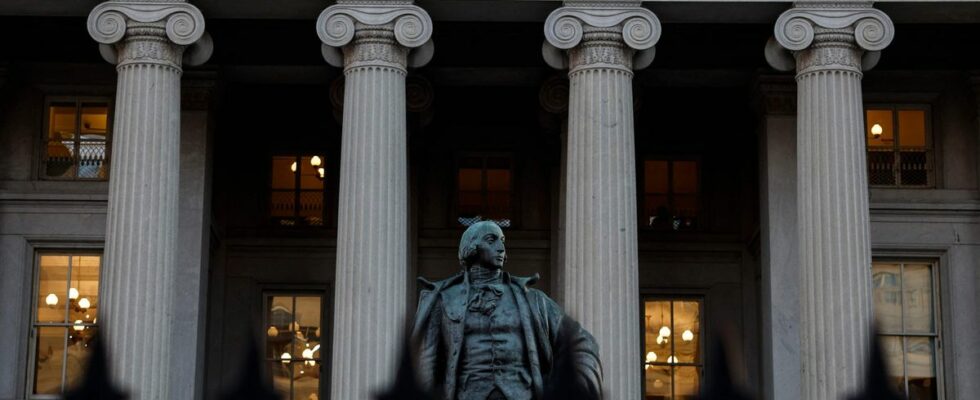From our correspondent in the United States,
Alexandre Hamilton would tear off his wig. On Thursday, the United States reached its debt ceiling, forcing the Treasury Department into a sleight of hand to ensure its financial commitments until June 5. Beyond that is the great uncertainty, with a standoff between Joe Biden and the majority Republicans in the House. And the specter of a historic default that could cause a global economic cataclysm.
What is the debt ceiling?
This is the maximum threshold of what the US state can borrow. The United States is one of the rare countries to have imposed a ceiling, and to have given, in 1917, full powers to Congress to raise it when necessary. The current limit, reached on Thursday, is 31.4 trillion (31.4 trillion) dollars. Consider a stack of 100 dollar bills linking the Earth to the Moon. Total debt is $94,000 per American, or 121% of annual US GDP.
Bill Gale, economist at the Brookings Institution, recalls an important point, which illustrates “the stupidity of the current debate”: “When we raise the debt ceiling, it is not a question of authorizing new expenditures but of knowing whether Congress authorizes the government to borrow for pay for expenses that Congress has already authorized.” The irony of the American system is that when elected officials vote on a budget, with income and expenditure, “they do not automatically authorize borrowing to make up the difference”.
Why is it stuck today?
For a long time, raising the debt ceiling was an almost automatic process. But since the 1990s, it has become a political battle, especially when there is a Congress divided between the two parties like today. Republicans, who are never so concerned about ‘mortgaging our grandchildren’s future by borrowing from China’ as when they’re not in the White House, refuse to raise the ceiling without good-daddy budget cuts of family. Joe Biden and the Democrats apply the American doctrine summed up by the left-wing economist Paul Krugman: we do not negotiate with “economic terrorists”.
Why is the United States not in default today?
“When we reach the debt ceiling, the Treasury uses accounting tricks to postpone the day of the last judgment”, continues Bill Gale. These are the famous “extraordinary measures” of savings announced by Secretary Janet Yellen. In particular, the cessation of payments to several retirement, health or disability funds for public officials and former soldiers, as well as a “period of suspension of debt issuance” until June 5. It is after that that the real risks begin.
Has the United States ever defaulted?
If the slogan “In God we trust” is written on the banknotes, the American machine works rather according to the motto “In debt we trust”. With the exception of an administrative error in 1979, the United States has never defaulted. This is why treasury bonds are considered safe bets around the world.
What will happen after June 5 without agreement?
During the summer “the State would default on debt interest payments or on other obligations, such as military salaries, Social Security (pensions) or Medicare (health for seniors)”, details Bill Gale. The Treasury would no doubt try to set priorities, but there is a legal vacuum and it could end up in court. According to analysts at Bank of America, a default is “likely in late summer or fall”, and it could last “from a few days to a few weeks”.
Is a defect really possible?
In 2011, under the administration of Barack Obama, the markets had plunged in the fall in the face of the threat of a default. For the first time in history, the S&P agency had lowered the rating of the American debt. An agreement had been reached at the last second to raise the ceiling. As with nuclear deterrence, no party wants to be responsible for an economic catastrophe. But the elected Republicans of the Freedom caucus, who have already put Kevin McCarthy through hell for his election as Speaker, could refuse to give in this time. Some have put on the table the possibility for the Treasury to mint a platinum coin and assign it the value of 1,000 billion dollars. But Janet Yellen dismissed this magic trick, which is debated among lawyers.
What would be the consequences of a default?
Mark Zandi, chief economist at Moody’s Analytics predicts a “financial Armageddon”. An alarmism that Bill Gale barely tempers: “The consequences of a major intentional default remain unknown, but the predictions range from ”serious to catastrophic”. With a loss of confidence in the dollar and in Treasury bills, a rise in interest rates for households, and a plunge in Wall Street – and therefore in personal retirement savings plans. “With the ramifications of the financial planet, this would spread to the global economy, as with the 2008 crisis. With economies already on the brink of recession, it would be crazy to risk a new global financial panic”, warns the economist . “The elect are playing with fire. »

